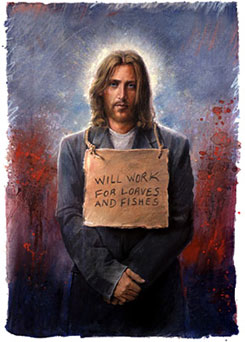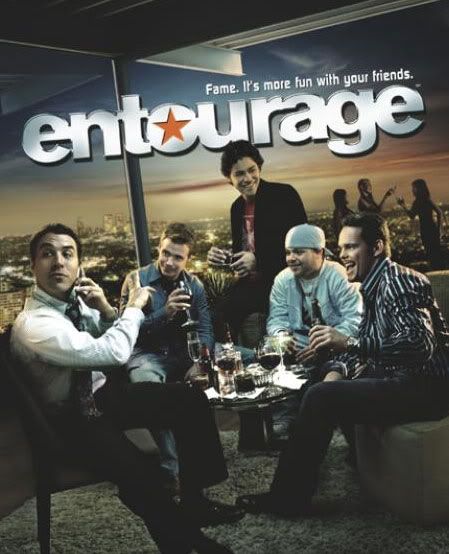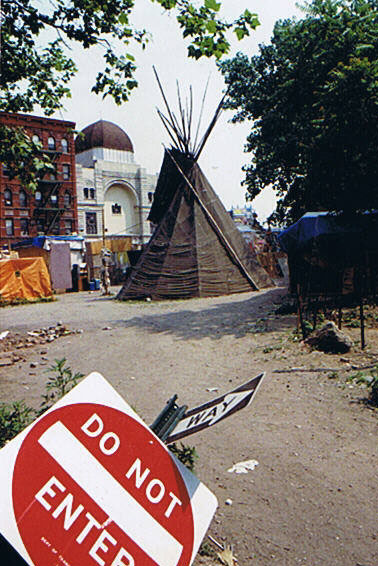Theatre Tribe
 Scott Walters opened an interesting discussion awhile back about new tribalism and theatre centering his reading of a section from Daniel Quinn’s book Beyond Civilization: Humanity’s Next Great Adventure. The discussion became the subject of numerous posts in the theatrosphere. Don Hall picked up on it as did Slay. Isaac asking about the sense of community amongst artists in a particular area is a parallel question. In Scott’s follow-up post he seems to have come to a conclusion on the nature of the theatre tribe in addressing Ian Hill‘s description of his theatre practice.
Scott Walters opened an interesting discussion awhile back about new tribalism and theatre centering his reading of a section from Daniel Quinn’s book Beyond Civilization: Humanity’s Next Great Adventure. The discussion became the subject of numerous posts in the theatrosphere. Don Hall picked up on it as did Slay. Isaac asking about the sense of community amongst artists in a particular area is a parallel question. In Scott’s follow-up post he seems to have come to a conclusion on the nature of the theatre tribe in addressing Ian Hill‘s description of his theatre practice.
…tribe is not only centered around an idea, but a place. It is comprised of a group of people who want to do a specific thing in a specific place. It isn’t a launching pad for “stardom,” but rather an end in itself, a way of life. If someone dreams of “moving up” to some more “prestigious” venue, then you don’t want him or her in your tribe. Tribes require a commitment. And they require a place, because it is the place, and the variety of people in that place, that provide constant stimulation and broadening. Ian writes, “When the tribe becomes a single theatre company, it tends to turn in on itself and not work as well — inbreeding produces defects.”
 While agreeing in part with the analysis, I would describe my own experience and observations of theatre as tribe in exactly the opposite manner as Scott (and Ian) do here. Hollywood and Broadway are actual places, but they are “places in the mind” first and foremost. In that way they are ideas that are in sync or counter to the central ethic of the theatre tribe.
While agreeing in part with the analysis, I would describe my own experience and observations of theatre as tribe in exactly the opposite manner as Scott (and Ian) do here. Hollywood and Broadway are actual places, but they are “places in the mind” first and foremost. In that way they are ideas that are in sync or counter to the central ethic of the theatre tribe.
American theatre, more than theatre in other countries, swims in the shared water of the big pool of dominant culture. So the theatre tribe may resemble an Entourage or Posse as much as they do a religious parish or political sect. I doubt Don, Ian, or Slay would turn down fame if Celebrity Culture offered it to them. Few American theatre groups I know are shunning “stardom” or “moving up” to a more “prestigious” venue. Even the ensembles that Scott has often cited on his blog as exemplars of theatre working with and toward community are all adept at representing and propagandizing their ideas. Box office is obviously dependent on the celebrity and fame of their “product,†but so is their funding and support from the NEA and other sources outside the local community.
For my own, the theatre tribe is nomadic by nature, always entering new hunting grounds in the pursuit of their idea. The tribe may have a preferred seasonal camp or hub, but its quest recognizes no borders. New members of the tribe open up new alliances and hunting grounds. New cultures are new cuisines of fresh ideas.
The tribe that centers around the idea of ABC No Rio‘s ‘culture of opposition’ goes back over twenty-five years to their founding. Its “squat” on Rivington Street became an emblem of the artistic community’s struggle with the real estate problem in New York City. Thieves Theatre was the first to do theatre there when No Rio commissioned us in an art exchange with Chicago’s Randolph Street Gallery in 1982. Five years later we would produce the world premiere of the controversial Fassbinder play Trash, The City and Death with them. In 1987 No Rio was the perfect performance space for presenting a play about how real estate speculation exploits and destroys the lives of the disenfrachised in a city.
Although the ownership of the brick and mortar building at 156 Rivington was always a rallying point of the contention between artists and the city, the battle was symbolic at best. When No Rio finally bought the building from the city last year for one dollar, it was a small victory for an artistic fringe community that had been displaced decades before through gentrification.
By the time NADA and other theatres Ian references began renting the buildings of Lower East Side near No Rio in the late ’80’s and early ’90’s, the area had already been gentrified out of the rent range of the original bohemian artists who had lived and worked there. Many of this artistic fringe moved to Williamsburg, DUMBO, and other parts of Brooklyn and beyond, where the gentrifying process began anew in a few of these areas. Any pioneering art scenes that may develop are all eventually co-opted. The DIE YUPPIE SCUM grafitti is always a short-lived resistance awaiting its whitewash. The recent announced move of the venue Galapagos from Williamsburg to DUMBO signifies a new trend exemplifying an “enlightened” real estate in partnership with a packaged and marketed “fringe art.” Meanwhile the idea, the philosophy and way of life that once was encapusalated under the notion of the fringe or bohemia, has long been in exile from “place” in New York City.
When Cindy Carr wrote about us in the early ’90’s in The Bohemian Diaspora, the epilogue article in her book On Edge: Performance at the End of the Century, we were living in a tepee in a Manhattan shantytown as art project. The tepee is the American icon of “the tribe,” but you can imagine how alien our “tent city” tribe was to its place. The various artists and homeless living there for three years never really belonged to the neighborhood and community encompassing it except as symbol; the shantytown represents the neglect and decay that are allowed to exist within the richest cities of the world.

Entrance for shantytown “The Hill” at Canal and Chrystie, 1991
After that project ended, although we continued to live in the rent controlled Brooklyn buiding we would eventually buy into, we began discovering our Temporary Autonomous Zones and tribe outside of New York, nationally within the ratconference we began in 1994. Rat became our community and audience for ten years. But as did most of what was once defined as the “fringe†everywhere, rat increasingly became peopled with more mainstream and/or institutional ambitions. However, even as rat was ending for us, we had rediscovered another vital fringe exploration in the physical theatre and butoh performance work of numerous international ensembles.
Community and tribe for us now are these mostly international friends and peers with an aesthetic that also projects an ethic, philosophy, and way of life that is counter to the dominant culture. And in most ways this is the same “culture of opposition” we had discovered with other NYC artists at No Rio in 1982.
Meanwhile over the twenty some years, our one-time fringe neighborhood in a landmarked section of brownstown Brooklyn has become ultra-chic. Olga and her extended Puerto Rican family have lived at “our place” for over fifty years and by now they are as much family as rent controlled tenant to us. We enjoy the company and friendship of most of our neighbors, old and new alike. Yuppie and bohemian no longer seem valid classifications. The neighbors are all invited to and participate in our art salon potlatches. Gawker Stalkers know celebs Michelle Williams and Heath Ledger live a block down the street, but our landlocked landmarked boat was just as famous a “love fetus” in neighborhood news as their daughter Matilda ever was.
Our landlocked landmarked neighborhood community is similar to how I feel connected to what is now being termed NYC Independent Theatre community. It is and isn’t my community. It’s a friendly enough place to hang, but I wouldn’t want to live there, all the time.
Landlocked landmarked. Most difficult is the escape from the museum of one’s own representation. Fellow travelers, I join my clan on the road just outside the walls.
3 thoughts on “Theatre Tribe”
Nick, I love your post here, and hate to defile it with a non-related comment. But you refuse to update with new posts as often as I would like you to (come on, get busy, i need more stuff to read at my boring day-gig). lol. And also, I don’t think it fair to carry on a conversation on someone else’s blog. So, here I am to pick up on the 365 commments on Parabasis (my fav’ blog), and only regret that we’re not doing this over a beer or something.
First, to be clear I said that I don’t know enough to disagree with you. In fact, I probably agree with you more that a can get across in a blog.
Next, if this is not your comment on Don’s blog, then I apologize (and I’ll be looking for some other Nick to have a drink with):
Nick said…
This whole 365 thing is nothing but a glorified shitty publicity campaign for Susan Lori Parks. The plays suck and the theatre companies, god love ‘m, don’t have a clue what to do with them. Although a few interpretations I saw were really funny. – nick.
But if this was your comment, I’d love to hear you elaborate sometime. I didn’t see enough to gather if others had a clue or not. I thought B&C and I were on to something, but that’s for others to judge, I guess. And I recall when Foreman directed SLP – beforehand every was saying what a great match, but afterward I heard a lot of ‘he didn’t have a clue’. Do SLP clues really even exist? I wish more folks had picked up on Don Hall’s initial post as a opportunity to discuss what makes this playwright’s work come alive or not. And if that applied to other writers. and so on.
Anyway, like I said, this is probably better discussed face-to-face, so maybe I have to wait till you Fudge the Pimp again. I look forward to that. In the meantime, please pass along my congrat’s to Gabriele on her NYIT nom’s.
-Ralph
No, Ralph, that comment is not mine. Any comments belonging to me will link to my blogger or Rat Sass identity. That’s an “anonymous Nick” with his stupid comment at Don’s. Not sure if he’s trying impersonate me or not.
Well Nick, sorry to confuse or allow myself to be confused. I’m still struggling with this bloggin’ stuff. To bad, too, I was hoping for a spirited conversation about the Secrets of SLP.
These 365 plays feel like a some kind of Rorschach test for directors. As I looked at the plays I kept having the impulse to do something to them, but then it seemed like the more one does the worse it gets.
I’d love to hear from more directors as to what they thought worked and didn’t work, and why, but that may be asking too much from the blog-world. And I also felt certain Tribual urges doing the 365, and thought there might be more discussion in the “Tribe” threads as to whether something like 365 might be today’s answer, good or bad, to that need. (or maybe it’s Harry Potter)
So now, I guess have to go searching for some other Nick. If I find him, he better have a clue or two, or I’ll ring his neck. All that said, I do hope that you’ll continue – and more often – to post some good ole rat sass here. You never fail to make me think.
Later, Ralph
Comments are closed.